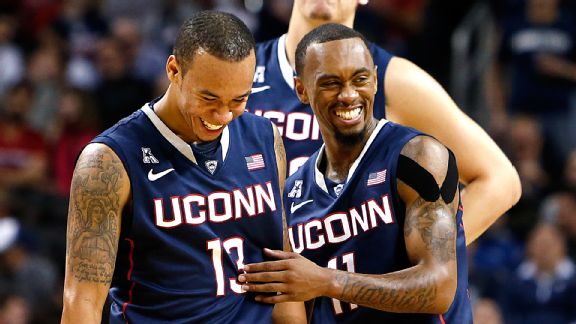UConn’s Statistical Profile Suggests a Correction is Coming, But How Far?
Posted by Bennet Hayes on December 19th, 2013Entering Wednesday night’s game against Stanford, it may have been easy for UConn fans to forget about “what could have been.” Because while snake-bitten teams like to dream about where they would be with a made shot here or a missed one there, the blessed teams inevitably fail to remember just how thin that line between winning and losing actually was. After all, a win is a win, right? Or in UConn’s case, nine wins was nine wins; hence the top 10 ranking and quickly escalating expectations. But if any Huskies – players, coaches or fans – forgot that their four best victories of the young season came by a total of five points, Wednesday night’s last-second loss surely reminded them that winning and losing can often look — if not feel — very similar. But should there be cause for concern in Storrs? Or would pressing the panic button make me us just as hyper-reactionary as those who anointed Shabazz Napier and company Final Four contenders after the win over Florida? Both are fair questions, but after a clunker of a second half turned in by the Huskies, I’m wondering just how much better this UConn team is than the last.

Thursday’s Loss To Stanford Notwithstanding, Shabazz Napier And Ryan Boatright Have Had A Lot To Laugh About So Far This Season. Do Tougher Times Lie Ahead For The Huskies?
Last season’s Huskies were far from bad. They went 20-10 (10-8 in the Big East), and finished 47th in KenPom’s final rankings. But much like the current UConn iteration, they didn’t enjoy taking care of business until the final seconds of the game – and often in the five minutes that followed. Kevin Ollie’s first team went 5-2 in overtime contests, and played a total of nine extra periods over the course of the season. Needless to say, their smoke and mirrors stuff didn’t just get started last month.
Last year’s encouraging season elicited hope that better days were ahead. Unfortunately, little besides the raw record has hinted that this team is prepared to reward that optimism. Production is actually down for a number of key regulars — most notably Ryan Boatright and Omar Calhoun. Boatright actually has a lower offensive rating this season than last, despite shooting an unsustainable 42 percent from three-point range so far (he nailed 33 percent last season). Calhoun’s drop-off has been far more precipitous; his points, rebounds, and assists per game are all down — as are his percentages from the field and three.









































